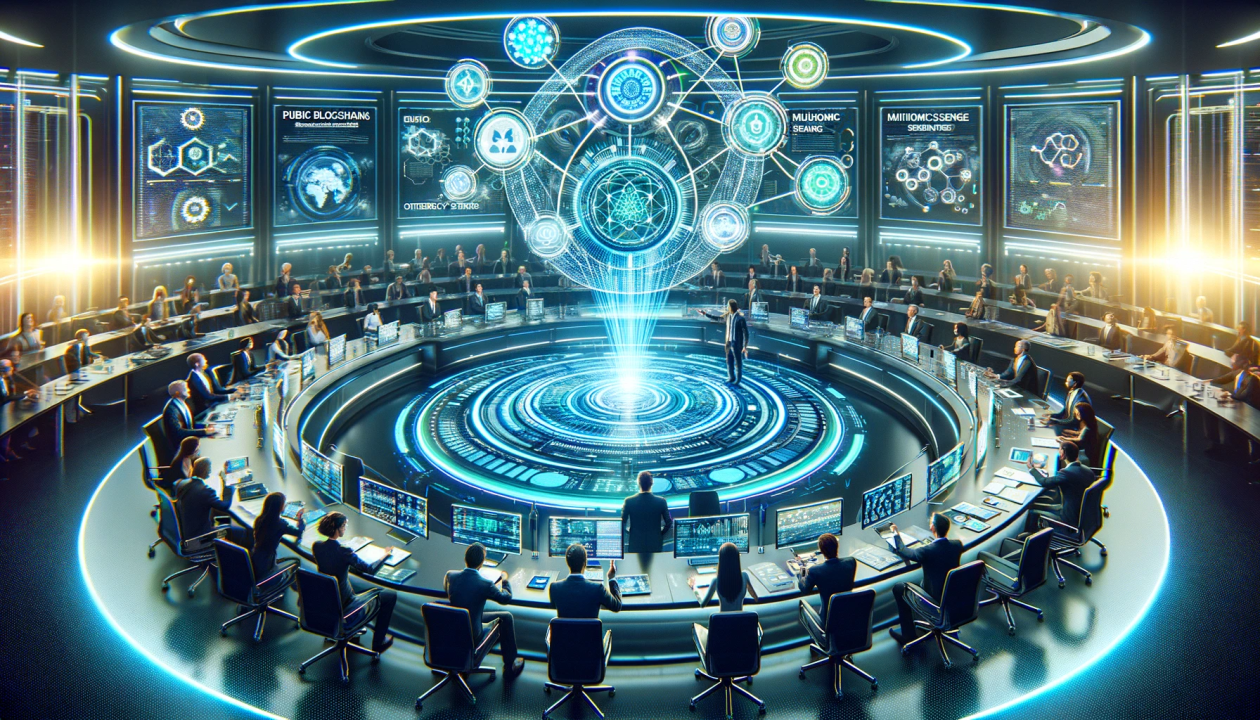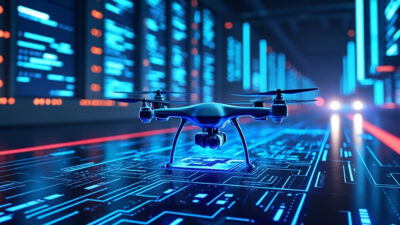The Convergence of Advanced Technologies Shaping the Future
The convergence of advanced technologies is revolutionizing how we interact with the digital and physical worlds. This integration, spanning fields like nanotechnology, biotechnology, information technology, and cognitive science, is creating unprecedented opportunities and challenges. As these technologies merge, they redefine industries, enhance human capabilities, and pave the way for a future where the boundaries between disciplines blur. This article delves deep into this transformative phenomenon.
Understanding Technological Convergence
Technological convergence refers to the merging of previously distinct technologies into unified systems, creating synergies that redefine industries and societal functions. Unlike simple integration, convergence involves the blending of capabilities, where the boundaries between technologies dissolve, enabling new functionalities that were previously unimaginable. This phenomenon is a cornerstone of modern innovation, driving efficiency, scalability, and transformative applications across sectors.
Historically, convergence has been a gradual process. The telegraph and telephone, once separate communication tools, evolved into interconnected networks, laying the groundwork for today’s digital communication systems. Similarly, the fusion of computing and telecommunications in the late 20th century birthed the internet, a prime example of how convergence can spawn entirely new paradigms. Today, this trend has accelerated, with breakthroughs like the Internet of Things (IoT) merging sensors, connectivity, and data analytics, while AI-driven automation combines machine learning, robotics, and cloud computing.
The significance of convergence lies in its ability to amplify the impact of individual technologies. For instance, smartphones epitomize convergence by blending computing, photography, navigation, and communication into a single device. This not only enhances user convenience but also fuels economic growth, spawning industries like app development and mobile commerce. In healthcare, the convergence of genomics, AI, and wearable tech enables personalized medicine, revolutionizing diagnostics and treatment.
However, convergence also presents challenges, such as interoperability issues and ethical dilemmas around data privacy. As technologies increasingly overlap, regulatory frameworks must evolve to address these complexities. Understanding this dynamic is crucial for navigating the future, where seamless integration will continue to redefine human interaction with technology. The next chapter will delve deeper into digital convergence, examining how computing and telecommunications have merged into a cohesive digital ecosystem.
The Role of Digital Convergence
Digital convergence represents the seamless integration of once-distinct technologies—computing, telecommunications, and broadcasting—into a unified digital ecosystem. This transformation has redefined how information is created, shared, and consumed, blurring the lines between industries and enabling unprecedented connectivity. At its core, digital convergence leverages advancements in processing power, data transmission, and software interoperability to create a cohesive framework where devices and services operate in harmony.
The shift from analog to digital formats laid the groundwork for this convergence. For instance, voice, video, and data now travel over the same networks, thanks to protocols like IP (Internet Protocol), which standardizes communication across platforms. Smartphones epitomize this integration, combining computing, telephony, and media playback into a single device. Meanwhile, cloud computing acts as the backbone, enabling real-time synchronization across multiple endpoints, from smart TVs to IoT sensors.
Key drivers of digital convergence include:
- Standardization: Universal protocols (e.g., 5G, Wi-Fi 6) ensure compatibility across devices and networks.
- Miniaturization: Smaller, more powerful chips allow multifunctional devices without compromising performance.
- User demand: Consumers expect seamless experiences, pushing industries to break down silos.
The implications are profound. Media companies now stream content globally, bypassing traditional broadcast constraints. Telemedicine platforms integrate diagnostics, video conferencing, and AI-driven analytics, revolutionizing healthcare delivery. Even financial services have transformed, with mobile banking merging transactions, identity verification, and customer support into a single interface.
As digital convergence accelerates, it sets the stage for deeper integrations, such as bioconvergence—where biological and digital systems intersect. This evolution underscores how foundational digital unification is to next-generation innovations.
Bioconvergence and Its Applications
The integration of biology with engineering—bioconvergence—is revolutionizing industries by merging biological principles with technological innovation. This synergy is unlocking unprecedented possibilities, from DNA data storage to bio-inspired materials, reshaping how we approach challenges in medicine, computing, and manufacturing.
One groundbreaking application is DNA data storage, where synthetic DNA strands encode vast amounts of digital information. Unlike traditional storage, DNA offers near-infinite density and longevity, with a single gram capable of storing exabytes of data. Companies like Microsoft and startups such as Catalog are pioneering this field, leveraging DNA’s stability to archive humanity’s knowledge for millennia.
In medical technologies, bioconvergence has led to breakthroughs like CRISPR-based gene editing, enabling precise modifications to genetic code to treat diseases. Similarly, bioelectronic medicine merges neural interfaces with biological systems, offering non-pharmacological treatments for chronic conditions. Wearable biosensors and organ-on-a-chip systems further exemplify this fusion, providing real-time health monitoring and accelerating drug development.
Bio-inspired materials are another frontier, where nature’s designs inform engineering solutions. For instance, self-healing polymers mimic biological tissue repair, while structural materials modeled after spider silk offer unmatched strength and flexibility. These innovations are transforming industries, from aerospace to construction, by enhancing durability and sustainability.
As bioconvergence advances, ethical and regulatory challenges emerge, particularly in genetic engineering and synthetic biology. However, its potential to redefine healthcare, computing, and material science underscores its pivotal role in the broader technological convergence landscape. This sets the stage for exploring the NBIC paradigm, where nanotechnology, biotechnology, IT, and cognitive science intersect to drive even deeper integration.
The NBIC Paradigm
The NBIC (Nanotechnology, Biotechnology, Information Technology, and Cognitive Science) paradigm represents a foundational framework for understanding how disparate fields are merging to create transformative advancements. This convergence is not merely additive but multiplicative, as breakthroughs in one domain catalyze innovations in others, leading to unprecedented capabilities.
At the nanoscale, materials and devices exhibit unique properties, enabling breakthroughs like targeted drug delivery and quantum computing components. Biotechnology leverages these advancements to engineer biological systems with precision, from CRISPR-based gene editing to synthetic biology. Information technology acts as the backbone, processing vast datasets generated by nanotech and biotech, while AI and machine learning uncover patterns too complex for human analysis. Cognitive science bridges these domains by enhancing human-machine interfaces, such as brain-computer integration, enabling seamless interaction between biological and artificial systems.
The NBIC framework’s power lies in its synergistic potential. For instance, nanotechnology enhances biotech tools, allowing for real-time monitoring of cellular processes, while cognitive science informs AI algorithms that optimize these interactions. This interplay accelerates innovation cycles, reducing the time from discovery to application. Unlike the bioconvergence discussed earlier—which focuses on biology’s integration with engineering—NBIC encompasses a broader, more systemic transformation, where each field elevates the others.
As industries adopt NBIC-driven solutions, they unlock efficiencies and capabilities previously unimaginable, setting the stage for the economic and industrial shifts explored in the next chapter. The NBIC paradigm is not just reshaping technology—it’s redefining the boundaries of human potential.
Impact on Industry and Economy
The convergence of advanced technologies is fundamentally transforming industries and economies, creating unprecedented opportunities while disrupting traditional business models. By integrating innovations like AI, IoT, blockchain, and biotechnology, industries are experiencing a paradigm shift in efficiency, customization, and scalability. For instance, smart manufacturing leverages AI-driven predictive maintenance and IoT-enabled automation to reduce downtime and optimize supply chains, while precision agriculture combines sensors, drones, and data analytics to maximize crop yields with minimal environmental impact.
New economic models are emerging as industries blur traditional boundaries. The rise of platform economies—where companies like Uber and Airbnb dominate by connecting supply and demand through digital interfaces—showcases how convergence enables asset-light, scalable businesses. Similarly, decentralized finance (DeFi) merges blockchain with traditional banking, offering peer-to-peer financial services without intermediaries. These shifts are accelerating globalization, as digital platforms erase geographical barriers, enabling even small enterprises to compete internationally.
However, this transformation also exacerbates economic disparities. Industries slow to adapt face obsolescence, while tech-savvy firms capture disproportionate market share. Automation and AI-driven efficiencies threaten job displacement in sectors like manufacturing and customer service, necessitating workforce reskilling. Meanwhile, data has become the new currency, with companies leveraging AI and IoT to monetize insights, raising concerns about monopolistic control—a theme further explored in the next chapter on ethical implications.
Ultimately, technological convergence is redefining value creation, with knowledge and innovation eclipsing traditional capital and labor as primary economic drivers. Policymakers and businesses must navigate this shift strategically to harness its potential while mitigating destabilizing effects on labor markets and industry structures.
Ethical and Societal Implications
The rapid convergence of advanced technologies—such as AI, IoT, biotechnology, and blockchain—brings transformative potential but also raises profound ethical and societal questions. As these innovations intertwine, they amplify both opportunities and risks, demanding careful consideration of their implications on privacy, equity, and human autonomy.
Privacy Concerns in a Hyperconnected World
The integration of AI with IoT and big data enables unprecedented surveillance and data collection, often without explicit consent. Facial recognition, predictive analytics, and biometric tracking blur the line between convenience and intrusion. For instance, smart cities optimize traffic and energy use but risk normalizing mass surveillance. The ethical dilemma lies in balancing efficiency with individual rights—how much privacy are we willing to sacrifice for technological advancement?
The Digital Divide and Access Inequality
While convergence drives economic growth, as discussed earlier, it also exacerbates disparities. Marginalized communities often lack access to high-speed internet, advanced healthcare tech, or AI-driven education tools, widening the gap between the “haves” and “have-nots.” Without inclusive policies, technological benefits may remain concentrated among elites, reinforcing systemic inequalities.
Autonomy and Algorithmic Bias
AI-driven decision-making in hiring, lending, and law enforcement raises concerns about fairness. Biased datasets can perpetuate discrimination, while opaque algorithms undermine accountability. The societal impact is clear: trust in technology erodes when systems replicate human prejudices. Ethical frameworks must ensure transparency and fairness to prevent harm.
As industries evolve through convergence, society must grapple with these challenges to ensure equitable progress. The next frontier—emerging fields like quantum computing and robotics—will only intensify these debates, demanding proactive governance and ethical foresight.
Future Trends in Convergence
The rapid convergence of advanced technologies is poised to redefine industries, economies, and daily life in the coming decades. Emerging fields like artificial intelligence (AI), robotics, and quantum computing are not just evolving in isolation but are increasingly intersecting, creating unprecedented opportunities and challenges. AI, for instance, is becoming the backbone of robotics, enabling autonomous systems to learn, adapt, and make decisions in real-time. Meanwhile, quantum computing promises to supercharge AI algorithms, solving complex problems in seconds that would take classical computers millennia.
One of the most transformative trends will be the fusion of AI and quantum computing. Quantum-enhanced machine learning could revolutionize drug discovery, financial modeling, and climate prediction by processing vast datasets with unparalleled speed. Similarly, the integration of AI into robotics will lead to more sophisticated human-robot collaboration, from precision surgery to disaster response. These advancements will blur the lines between physical and digital realms, giving rise to cyber-physical systems that operate with minimal human intervention.
Another critical area is the convergence of biotechnology and nanotechnology with AI-driven diagnostics. Imagine nanobots powered by AI navigating the human bloodstream to detect and treat diseases at the cellular level. Such innovations could render traditional healthcare obsolete, shifting the focus from treatment to prevention.
However, these breakthroughs will also demand robust frameworks to address scalability, interoperability, and security. As technologies merge, the risk of systemic vulnerabilities grows, requiring adaptive governance and cross-disciplinary collaboration. The future of convergence lies not just in technological prowess but in our ability to harness it responsibly, ensuring equitable access and mitigating unintended consequences. This sets the stage for examining real-world applications, as explored in the next chapter.
Case Studies of Convergence
The convergence of advanced technologies is already transforming industries, as demonstrated by real-world applications that blend multiple innovations. Smart devices exemplify this trend, integrating AI, IoT, and edge computing to create seamless user experiences. For instance, modern smart home ecosystems combine voice assistants like Alexa with IoT-enabled appliances, security systems, and energy management tools. These systems leverage machine learning to adapt to user behavior, optimizing energy use and enhancing convenience while maintaining interoperability across brands.
Wearable technology further illustrates convergence, merging biometric sensors, cloud computing, and AI-driven analytics. Devices like the Apple Watch or Fitbit track health metrics in real time, syncing data to cloud platforms where AI algorithms detect anomalies and provide personalized recommendations. Some wearables now integrate with electronic health records (EHRs), enabling doctors to monitor patients remotely—a critical advancement in preventive care.
Perhaps the most impactful convergence is seen in integrated healthcare systems, where AI, big data, and robotics collaborate to improve outcomes. Robotic surgery systems, such as the da Vinci Surgical System, combine precision robotics with real-time imaging and AI-assisted decision-making. Meanwhile, platforms like IBM Watson Health analyze vast datasets to identify treatment patterns, accelerating drug discovery and personalized medicine.
These case studies highlight how convergence isn’t just theoretical—it’s driving tangible advancements. However, as the next chapter will explore, challenges like data silos, regulatory gaps, and compatibility issues persist, slowing broader adoption. The seamless integration seen in these examples remains the exception rather than the norm, underscoring the need for standardized frameworks to unlock the full potential of converging technologies.
Challenges and Barriers
The convergence of advanced technologies promises transformative potential, yet several challenges hinder its full realization. Regulatory hurdles remain a significant barrier, as disparate legal frameworks struggle to keep pace with rapid innovation. For instance, data privacy laws like GDPR in Europe and CCPA in California often conflict with less stringent regulations elsewhere, creating compliance complexities for global enterprises. Additionally, emerging fields like AI and quantum computing lack standardized oversight, leading to fragmented policies that stifle cross-industry integration.
Technical limitations also impede seamless convergence. While IoT devices, AI, and 5G networks individually advance, their interoperability is hampered by incompatible protocols and legacy systems. For example, smart cities integrating autonomous vehicles with traffic management systems face latency and synchronization issues due to heterogeneous communication standards. Similarly, quantum computing’s nascent state restricts its compatibility with classical computing infrastructures, delaying hybrid solutions.
Interoperability issues further complicate convergence. Proprietary ecosystems, such as those maintained by tech giants, often lock users into closed platforms, limiting cross-platform functionality. Healthcare systems, despite leveraging AI and wearables, struggle with siloed data formats that prevent holistic patient analytics. Moreover, cybersecurity vulnerabilities multiply as interconnected systems expand attack surfaces, demanding robust yet flexible security architectures.
Economic and ethical concerns add another layer of complexity. The high cost of R&D and infrastructure upgrades discourages SMEs from adopting converged solutions, while public skepticism about AI bias and automation-driven job losses fuels resistance. Addressing these challenges requires collaborative standardization efforts, adaptive policymaking, and investment in open-source frameworks to bridge gaps. Only then can the vision of a seamlessly converged technological future be realized.
Preparing for a Converged Future
The rapid convergence of advanced technologies—AI, IoT, blockchain, quantum computing, and biotechnology—demands proactive adaptation from individuals, businesses, and governments to harness its full potential. To thrive in this evolving landscape, stakeholders must adopt forward-thinking strategies that address both opportunities and disruptions.
For individuals, continuous learning and digital literacy are paramount. The workforce must upskill in emerging fields like AI-driven automation, cybersecurity, and data analytics. Lifelong learning platforms, micro-credentials, and interdisciplinary education will bridge skill gaps. Additionally, fostering adaptability and ethical awareness will help navigate the societal and economic shifts brought by converged technologies.
Businesses must prioritize agility and cross-industry collaboration. Investing in interoperable systems and modular infrastructure ensures seamless integration of new technologies. Companies should also embrace open innovation, partnering with startups, academia, and competitors to co-develop solutions. Data governance and cybersecurity frameworks must evolve to mitigate risks while enabling secure data sharing across ecosystems. Scenario planning will help anticipate disruptions, ensuring resilience in dynamic markets.
Governments play a critical role in shaping policies that balance innovation with public welfare. Regulatory sandboxes can foster experimentation while safeguarding ethical and security standards. Policymakers must collaborate internationally to harmonize standards, addressing interoperability and data sovereignty challenges. Public-private partnerships can accelerate infrastructure development, ensuring equitable access to converged technologies. Proactive investment in R&D and digital public goods will drive inclusive growth.
Ultimately, preparing for a converged future requires a holistic approach—combining education, strategic investment, and adaptive governance. By aligning efforts across sectors, society can mitigate risks while unlocking transformative opportunities in this new era of technological synergy.

Conclusions
The convergence of advanced technologies is not just a trend but a fundamental shift in how we innovate and solve complex problems. By integrating diverse fields, we unlock new possibilities that were once unimaginable. However, this journey requires careful navigation of ethical, societal, and technical challenges. As we stand on the brink of this new era, the potential for transformative change is limitless, provided we approach it with foresight and responsibility.



